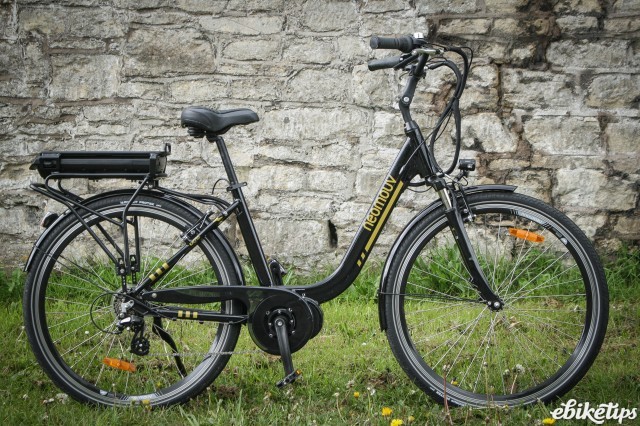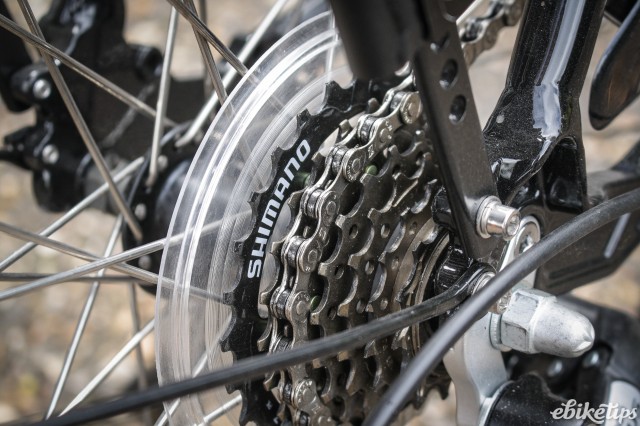Neoumouv Kalyso

Overview
- Good city riding position
- Motor has enough power for steeper stuff
- Decent range with bigger batteries available
- Fork is awful
- Motor can buck from a standstill
- V-brakes on a £1500 bike feel a bit cheap
The Neoumouv Kalyso is a decent city bike with the company’s own mid motor for assistance. It’s a comfortable ride, and there’s enough power on tap to get up most of the hills you’ll encounter, but it doesn’t really stand out at this price.
Buy the Neoumouv Kalyso here
“Kalyso will turn mundane bike rides into comfortable glides”, says French brand Neomouv. “An upright riding position lets you enjoy the view and suspension forks even out the ride so you can focus on beauty not bumps.”
The step-through frame is nicely made, and about as low a step as it can be given the position of the motor. That makes it very easy to get on and off. The bike is offered in a single 46cm size, which actually translates into a bike that feels quite big; I’m 1.89m and I certainly don’t feel too big for it. There are 26” and 28” wheel options, the former of which will make the bike sit a touch lower for smaller riders, but if you’re very small it’ll still feel a bit rangy. My review bike had the big wheels. The seatpost has a good range of adjustment and there’s an adjustable stem to fine-tune your position.
Out and about the Kalyso is an easy bike to ride. It’s easy to get on and off, the ride position is classically upright to give you a good view of goings on, and the wide, swept bars with their ergonomic grips are comfortable and easy to control. The big saddle looks like it’s designed for shorter trips but I didn’t have any issues with it on the longer rides I completed.
The motor is Neomouv’s own mid motor system, Neoassist. In terms of form factor it’s not dissimilar to a Bosch Active Line motor, and like the new Active Line units it’s direct drive to the chainring. Unlike the Bosch motors – and indeed most of the motors – it’s not torque sensing... well, not really. It senses torque to apply power from a standstill, but it’s in an on/off kind of a way, so if you step on the pedals when it’s in a high mode you’ll get the works from the motor, rather than it easing you in. That’s great when you’re kicking off from the traffic lights in town, and significantly less so when you accidentally kick a pedal when you’re manoeuvring it through a door, or into a bike rack. Once you’re going the motor will keep going so long as you’re pedalling, even if you’re just turning the cranks round, so it’s possible to cruise along with no effort at all on the flat.
Hit the hills and the Neoassist motor has enough oomph to get you up them. We’re not talking mountain-bike-motor levels of go here, but on my benchmark commuting hill (1.5km at 5%, with a 12% section) it was perfectly possible to amble up without taxing the legs. Not at any great pace, but without any issues. The Neoassist isn’t as quiet as newer motors from Shimano and Bosch but it’s not intrusive either. Unless you live somewhere very challenging – or you’re always in a hurry – it should be enough motor for your needs. It probably sits just below a Bosch Active Line motor, and above most of the hubs you’ll usually find on bikes from this kind of price down.
The gearing helps. The Shimano Altus 7-speed transmission doesn’t have a massive range from top gear to bottom, but Neomouv has sensibly opted to limit it at the high end rather than the low. So above about 30km/h you’ll be spinning your legs pretty quickly, but it’s rare that you’d ever want to do anything other than freewheel as that kind of speed on a bike like this. At the other end, bottom gear is low enough that even on steeper inclines you have a gear you can spin rather than grind.
If going up is a joy, going down is less so. Part of that is down to the fork. I do tend to go on about cheap suspension forks on bikes like this. None of your weight is really on your hands, and the bike has decent air chambers in its Michelin Protek tyres to take the sting out of bumps. So even a good fork is a luxury, and a bad fork like the one used here makes the bike feel worse, not better: the poorly-managed rebound kicks the front wheel up over speed bumps and the minimal travel bottoms out with a clang over anything bigger than a ripple in the tarmac. It’s flexy under braking and at speed. It’s comfortably the worst fork I’ve tried on an e-bike, and that’s up against some pretty stiff competition. And that’s the only sentence about this fork in which I’d use the words ‘comfortably’ and ‘stiff’. Let’s move on.
So the fork isn’t great, and the brakes aren’t great either. They’re not bad like the fork is, more average really. A few years ago I might have commented on how they stop the bike well enough and moved on, but hydraulic discs are ubiquitous enough now at this kind of money that it’s a pity that the Kalyso doesn’t have them. Promax make perfectly functional budget brakes, and I’ve never been unable to haul myself to a standstill. They are budget brakes though, and not as good as budget hydraulic discs.
Range-wise the Kalyso is middle of the pack. At the moment you get an upgrade from the standard 360Wh battery to the 480Wh unit my review bike was supplied with, and that’s worth £136. It’s a reasonably heavy bike, and the motor power isn’t quite as intelligent as some others out there, so it burns through a little bit more capacity as a result. I managed four laps of my hilly commute (9km round trip with 160m of climbing) before range anxiety got the better of me, and my general rule of thumb is that 100Wh per commute is good. So a 400Wh bike that does four commutes is good; this is a 480Wh bike that does four, so it’s about par. It might be able to do more, but the battery indication on the LCD isn’t helpful. If the battery icon says three bars out of five when you’re at a standstill, and one bar when you’re pedalling, which is it? I tended to split the difference. For flatter riding in the city and on leisure trails you’d get near the 40-mile (64km) claimed range. If that’s not enough then the bike is also available a 580Wh battery upgrade at the point of sale.
In terms of value overall, the Kalyso is decently specced but you wouldn’t say it was stellar value. What else can you buy for a similar spend? Well the EBCO UCL 30 is the same price, and for that you get a similar build with a cadence-sensing Tranzx mid motor, although the transmission is upgraded to 8-speed and the headstock fork is a significant improvement over the one used on the Kalyso. Carrera’s long-serving Crossfire E is also 8-speed, and you get hydraulic disc brakes and a bigger battery as standard. The step-through isn’t as low, and it’s a hub motor not a mid motor, but in terms of power it’s on a par, and it’s £250 cheaper as well. The Juicy Bikes Roller is a shade more expensive than the Kalyso, but again you get a much improved fork, hydraulic discs and a better transmission. If you can scrape another £200 from the back of the sofa then you’ve enough to upgrade to a Cube Cross Hybrid One 400 Allroad - and it really is an upgrade: Bosch motor, hydraulic disc brakes, 9-speed gearing and a half-decent fork. Again, though, it’s not a full low-step and the sportier position might not suit you if you’re after something more leisurely.
Overall I enjoyed riding the Kalyso, but it didn’t really do anything to distinguish itself. If you’re looking for a decently-specced mid motor bike then £1,500 really is about the bottom of the market in terms of spend, and for that you’re getting a motor that’s good enough for the hills with a decent range to boot. The brakes feel a little bit compromised, and the fork lets the bike down. It’s not a deal-breaker, and overall the bike is decent, but I think there are better choices in the market right now.














